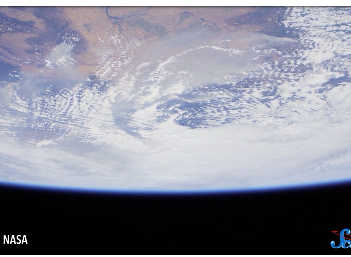(单词翻译:单击)
Our rocky planet is a great place for life, but we can’t give it all the credit.
我们的岩态行星是个适合生命存活的好地方,但所有的功劳并不全属于地球。
Life on Earth has always been shaped by other bodies in space.
地球上的生命总是由太空中的其他物体塑造的。
Thanks to the Sun and Moon, we have important cycles like days, seasons, and tides—and we have meteors and asteroids to thank for helping deliver our planet’s water.
多亏了太阳和月亮,我们才有了像天、季节和潮汐这样重要的周期,我们还要感谢流星和小行星为我们的星球提供了水。
But those aren’t the only ways these celestial objects influence life on our planet—and life in our oceans is especially susceptible to their meddling.
但这并不是这些天体影响地球上生命的唯一方式——海洋中的生命尤其容易受到它们的影响。
For example, whales seem to be sensitive to activity in the Sun.
例如,鲸鱼似乎对太阳的活动很敏感。
For years, researchers were trying to figure out why whales that seemed perfectly healthy kept getting stranded on beaches.
多年来,研究人员一直试图弄清楚,为什么看起来非常健康的鲸鱼总是会在海滩上搁浅。
Early studies pointed to human activities like shipping, which generate massive amounts of noise underwater.
早期的研究将矛头指向人类活动,比如在水下产生大量噪音的船舶。
They thought the whales might be getting disoriented because they were overloaded with sound.
他们认为鲸鱼可能因为超负荷的声音而迷失了方向。
Then, a 2020 study that looked at gray whales suggested that another reason they’re getting stranded is because solar storms are messing with their ability to sense Earth’s magnetic field.
然后,2020年一项对灰鲸的研究表明,它们搁浅的另一个原因是太阳风暴破坏了它们感知地球磁场的能力。
Solar storms happen when the Sun releases huge amounts of energy in a burst of charged particles that radiate outward.
当太阳爆发向外辐射的带电粒子释放大量能量时,就出现了太阳风暴。
During severe storms, these charged particles rain down on Earth’s magnetic field and can make it change in shape.
在剧烈的风暴中,这些带电粒子降落在地球磁场上,使其改变形状。
For humans, that’s bad news because it can mess with communications and produce electrical surges in our power grids.
对人类来说,这是个坏消息,因为它会干扰通信,并在电网中产生电涌。
But scientists suspected that it might also interfere with whale navigation, since they were pretty sure whales relied on magnetic fields to get around.
但科学家们怀疑,磁场也可能会干扰鲸鱼的导航,因为他们非常确定鲸鱼是依靠磁场四处走动的。

To find out, researchers compared 31 years’ worth of data on gray whale strandings and solar activity—and, sure enough, the most strandings happened during times with lots of solar storms.
为了找到答案,研究人员对比了31年来灰鲸搁浅和太阳活动的数据——可以肯定的是,大多数搁浅发生在太阳风暴频繁的时候。
So they think that outbursts from the Sun are getting in the way of whale navigation—which backs up the idea that whales are using magnetic navigation to get around the globe.
所以他们认为是太阳风暴妨碍了鲸鱼的导航——这支持了鲸鱼使用磁导航到处游动的观点。
And it could also give us a starting point to explore how solar activity affects the navigation of other creatures on Earth.
这也为我们探索太阳活动如何影响地球上其他生物的导航提供了一个起点。
But interactions with celestial bodies aren’t all disruptive.
但与天体的相互作用并不都是破坏性的。
In some cases, they can be really helpful.
在某些情况下,它们真的很有帮助。
For instance, the Moon appears to play a big role in the development of a reef-dwelling fish called the common triplefin.
例如,月球似乎在一种被称为普通三鳍鱼的礁栖鱼的发育过程中发挥了重要作用。
We don’t know a whole lot about these baby reef fish, because they’re tiny and hard to track.
我们对这些礁鱼宝宝了解不多,因为它们很小,很难追踪。
But we do know that as babies, common triplefins trek out to the open ocean and spend at least 51 days there before moving on to full-time life on the reef.
但我们知道,普通三鳍鱼在小的时候会长途跋涉到开阔的海洋,至少在那里度过51天,然后才会一直在礁石上生活。
The thing is, the journey to and from the reef is not especially safe for baby fish, so scientists wondered why they would have evolved that strategy.
问题是,对于幼鱼来说,往返于珊瑚礁之间的旅程并不是特别安全,所以科学家想知道它们为什么会进化出这种策略。
In a 2018 study, they hypothesized that moonlight in the open ocean might be helping the fish track down the food they need to grow into adults—since the open ocean would be better lit than the shadowy reefs.
在2018年的一项研究中,他们假设开阔海洋的月光可能有助于鱼类找到它们长大所需的食物——因为开阔海洋里的光照要比阴暗的珊瑚礁更好。
To investigate, they studied a structure in the fish’s inner ear called the otolith.
为了调查,他们研究了这种鱼内耳中一种叫做耳石的结构。
All fish have this structure, and it’s useful because it lays down growth rings, kind of like a tree.
所有的鱼都有这种结构,它很有用,因为它能留下年轮,就像树木一样。
So, by examining it, scientists can see how the fish grow over time.
因此,检查耳石科学家就能知道鱼是如何随时间生长的。
In this study, researchers examined the otoliths of more than 300 adult triplefins.
在这项研究中,研究人员检查了300多条成年三鳍鱼的耳石。
They looked at how patterns in the rings lined up with the lunar cycle and weather conditions to see what factors influenced their growth.
他们研究了耳石上的图案是如何与月球周期和天气状况相匹配的,以了解是什么因素影响了它们的生长。
And they found that when the triplefins were babies, they grew faster during bright, moonlit nights.
他们发现,当三鳍鱼还是幼鱼的时候,它们在明亮的月光下生长得更快。
The researchers believe that brighter moonlight helps the baby fish see at night, so they can hunt more plankton—and pack on the pounds.
研究人员认为,明亮的月光有助于小鱼在晚上看清东西,这样它们就可以捕食更多的浮游生物,从而增加体重。
They also think the Moon might help the baby fish relax—because their predators are hiding from their own predators on bright nights, so the triplefins have less to look out for!
他们还认为,月亮可能会帮助小鱼放松——因为它们的捕食者要在明亮的夜晚躲避自己的捕食者,所以三鳍鱼没有那么多需要担忧的东西!
While the Moon is helping baby fish to grow, meteors are fertilizing the growth of phytoplankton.
当月亮帮助小鱼成长时,流星也在为浮游植物的生长施肥。
These are tiny plants that make up the base of the entire ocean food chain.
这些微小的植物构成了整个海洋食物链的基础。
And to grow in large numbers, they need some help from outer space.
要想大量繁殖,它们需要外太空的帮助。
See, these tiny organisms rely on a bunch of dissolved nutrients, like nitrogen, phosphorus, and especially metals, like iron.
这些微生物依赖于大量溶解的营养物质,比如氮、磷,尤其是金属,比如铁。
But dissolved metals are often in short supply.
但是溶解金属经常很短缺。
Like, they’re around a thousand times less concentrated than other nutrients—and that puts a limit on the amount of phytoplankton that can grow.
比如,它们的浓度比其他营养物低1000倍左右,这就限制了浮游植物的生长。
Which could put these organisms in a tight spot in remote places like the Southern Ocean, where there’s not a lot of dust blowing off the land to put iron in the sea.
这可能会让这些生物处于像南大洋这样偏远地区的困境中,那里没有太多从陆地上吹来的灰尘将铁带入海洋。
That’s where meteors come into the picture.
这就是流星出现的原因。
Every day, thousands of mostly-small meteors burn up in the planet’s atmosphere and turn into space dust.
每天,数千颗大多很小的流星在行星的大气层中燃烧,变成太空尘埃。
It’s estimated that around 40 thousand metric tonnes of space dust accumulates on our planet each year!
据估计,每年大约有4万公吨的太空尘埃聚集在我们的星球上!
And this dust is full of iron.
这些尘埃里全是铁。
Researchers estimate that in remote marine regions, space dust contributes up to 300 percent more iron than any other source, providing the nutrients phytoplankton need to thrive!
研究人员估计,在偏远的海洋地区,太空尘埃提供的铁要比任何其他来源高出300%,为浮游植物提供了茁壮成长所需的营养!
Without the help of space dust, the ecosystems of far-flung locations would likely look completely different, with a lot less phytoplankton to fuel the food web.
如果没有太空尘埃的帮助,偏远地区的生态系统可能会完全不同,供养食物链的浮游植物会大大减少。
So every day, along with driving the natural cycles living things depend on, objects in space are meddling with marine organisms in subtle ways that have huge effects on life as we know it.
所以每一天,在推动生物赖以生存的自然循环的同时,太空中的物体也在以微妙的方式干扰着海洋生物,对我们所知的生命产生巨大的影响。
Thanks for watching this episode of SciShow Space!
感谢收看本期《太空科学秀》!
And if you enjoyed it, you might like our episode on eight truths and myths about the full Moon, which you can find right after this!
如果你喜欢本期内容,你可能也会喜欢我们关于满月的八个事实和神话,接下来你就可以收看那个视频!


